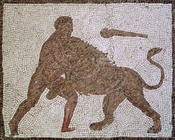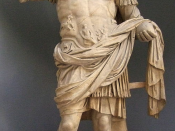In ancient Rome, as with the majority of ancient cultures, religion and politics played an essential role in the making of art. Although new approaches towards art developed, such as portraiture, art was primarily used as a means of political messages and of religious worship. This is evident in two pieces from the early empire (27 BC- 96CE), the "Bronze Heracles" (30BC-70CE) which was used mainly for religious purposes, and the "Marble Torso Clad in a Cuirass" (90-96CE) which used as a political promotion for Emperor Domitian or one of his generals (MFA).
Heracles the half human and half god, bastard son of Zeus, was the most popular of all the mythological figures in ancient Greece and Rome. His immense popularity can be attributed to the fact that he was half human, not especially bright, and tremendously strong. Many could identify with him, and it was reasonable for people to aspire to be like him.
It is evident that Heracles was extremely popular, because of the vast quantity of artworks representing him. Common representations of the hero were medium sized bronze statuary and smaller statuettes. The "Bronze Heracles" located at the Museum of Fine Arts in Boston, Massachusetts. It stands 101 cm tall and dates to 30 B.C.-C.E. 70. The statue was found broken near Norcia in Umbria, Italy (MFA). It has been reconstructed, and some parts in the middle of the back, the upper thigh, and the head and mane of the lion have been restored. Although Heracles is thought to have been holding a club in his left hand, and also have eyes inlaid with other materials such as copper, gold, or ivory, these part have not been restored. Bronze Heracles was made by hollow-casting, or the lost- wax method, developed by the Greeks. It is...


